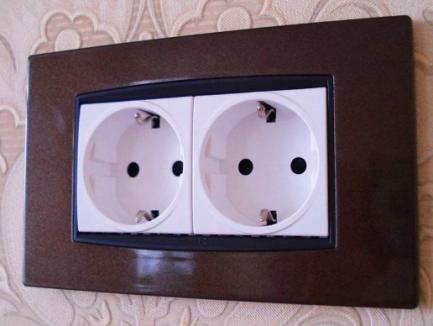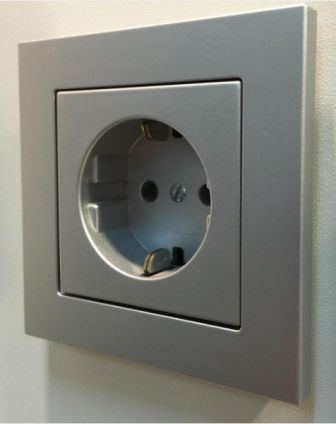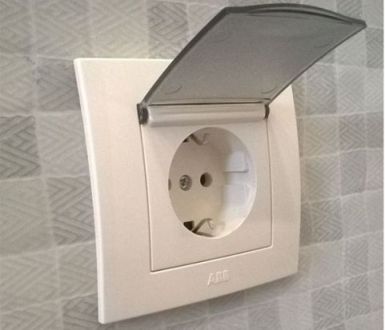Categories: Sockets and switches
Number of views: 33890
Comments on the article: 0
How to install and connect an additional outlet to the wiring
A situation is quite common when the established number of outlets in a room in an apartment is not enough to simultaneously include all the necessary household appliances in the network. In this regard, one or several electrical appliances have to be connected to the network one at a time, which is not very convenient and ordinary household chores are delayed in time. How to solve this problem?
If the wiring is quite old and is in unsatisfactory technical condition, then it is necessary to replace it, mounting a new wiring already with the number of outlets necessary for convenient operation. But this option, as a rule, is combined with the overhaul of an apartment or a private house, since with a complete replacement of the wiring it will be necessary to violate the integrity of the finish coating of the walls and ceiling throughout the house.

If major repairs are not planned in the near future, then the most optimal and least expensive option is to install an additional outlet or several outlets in a room. Also, this option will be relevant for the case if the wiring is in normal technical condition or when a complete replacement of the apartment electrics was made relatively recently. Consider in this article in detail the question of how to install and connect an additional outlet to the wiring.
Choosing a way to install an outlet and install a cable
If you need to install an additional outlet, you first need to decide which type of outlet to choose - external or internal installation, that is, an invoice or a built-in one. The same applies to the cable from the outlet to the area of the wiring to which it will be connected - in this case, you can also choose a hidden or open way to install the cable. What method of mounting the outlet and laying the cable to choose?
A built-in socket, like a hidden wiring line from an aesthetic point of view, is the most acceptable option. But it should be borne in mind that for laying a new hidden wiring line, as well as installing an embedded outlet, it will be necessary to wall the wall, make a hole for the installation box. This will create a lot of dust, dirt, which is unacceptable in a residential apartment or house. Also, when installing hidden electrical wiring, the finish of the wall will be damaged.
While installing the cable in an open way, as well as a wall-mounted outlet, allows you to work with the lowest labor costs, with the minimum amount of dust and dirt, and the wall covering will not be damaged, where it is planned to lay the cable and install a new outlet. But in this case, the mounted wiring section will be visible, which is not very aesthetically pleasing.
In this case, when choosing the method of cable installation and choosing the type of outlet, it is necessary to choose the most optimal option, depending on the relative position of the interior elements in the room. For example, if a section of the electrical wiring passes behind some element of the interior, then it is more advisable to choose the simplest way - the external method of mounting the electrical wiring, since it will not be visible anyway.
In the event that the walls are finished with plasterboard, the installation of hidden electrical wiring elements is greatly simplified. To install the outlet in this case, you must select an empty opening between the profiles mounted on the wall and make a hole for the mounting box.
If the outlet is located under the junction box, then the wire of the wiring line can be laid in the void between the profiles. Or stretch the wire down, and lay the wire below in the cable channel for open wiring or in the baseboard, which structurally has a channel for laying the cable. There are many options - it all depends on local conditions and personal preferences.
The next, most important stage is the selection of the most optimal way to connect an additional outlet to one of the sections of the existing electrical wiring. In this case, it is necessary to take into account the estimated load that will be included in the new installed outlet and, based on these data, choose one of the connection methods discussed below.

Connection from another outlet (by cable)
Consider the first and easiest way connecting a new outlet with a loop. This method involves connecting the cable to a new additional outlet from an existing outlet in the room. This method can be used only if it is necessary to connect an additional outlet to power a small load.
In this case, it means such a load that, in total with the load of the outlet from which it is planned to connect, will not exceed the allowable for the cable and other elements of the wiring supplying the first outlet. That is, you can connect one outlet from another with a loop, provided that the total load of these two outlets does not exceed the allowable for this section of the wiring.
In this case, it is also necessary to remember that when connecting an additional outlet with a loop, the total load current of both outlets will flow through the contact terminals of the first outlet. Therefore, it is impossible for the total load of two outlets to exceed the allowable for the first outlet.
For example, if the total load of two sockets is 20 A, then for a cable with a cross section of 2.5 sq. mm supplying the first outlet, this load will be lower than the nominal, but for the first outlet, the permissible current for which is no more than 16 A, this load will be unacceptable and the outlet will quickly fail if both outlets are used simultaneously.
Junction Box Connection
The next way is to connect an additional outlet in the nearest junction box. Before connecting the outlet to an existing junction box, make sure that the wiring section supplying the junction box has enough load capacity to connect a new outlet.
For example, you need to connect an additional outlet to supply a load of 10 A. In the nearest junction box, two sockets with a total capacity of 14 A are already connected. The cable that is routed from the home switchboard to this junction box has a cross section of 4 square meters. mm At the moment, a circuit breaker for a rated current of 16 A is installed to protect this wiring line.
When installing a new outlet, the total load of three outlets will be 24 A. For the cable through which this junction box is powered from the shield, such a load is permissible. That is, this option to connect the outlet is allowed. But it should be noted that if the load on this wiring section increases, it will be necessary to replace the circuit breaker from 16 to 25 A. Such a circuit breaker will protect the cable from overload, but the sockets will not be fully protected, since the rated current of each of the sockets is 16 A, and the rated value for the circuit breaker is 25 A.
Direct connection from the main switchboard
The third method involves the direct connection of an additional outlet from the main distribution panel of the apartment.This method is relevant for connecting powerful electrical appliances, as well as for cases when the load capacity of a particular section of the electrical wiring or the installed electrical wiring as a whole does not allow you to connect an additional outlet using one of the above methods - from a junction box or from another outlet.
The main advantage of direct connection of the outlet from the distribution panel is its high reliability, which is due, firstly, to the absence of intermediate contact connections, and secondly, to reliable protection, since an individual circuit breaker is selected to protect this section, taking into account the permissible currents for all elements this wiring line.
In all cases, it is necessary to select the required cable section for connecting an additional outlet. Typically, a cable with a cross-section of 2.5 square meters is selected to power ordinary outlets. mm But if we are talking about connecting a powerful household appliance (direct connection from the panel), then in this case the cable section must be selected based on the load of this appliance, since 2.5 sq. mm may not be enough.

Installation and connection of an additional outlet
When a suitable method of connecting a new outlet is selected and its location is determined, we carry out preparatory work. If you choose the hidden method of laying the cable and installing the hidden socket, the preparation of the shtroba and the place for the mounting box under the new socket is performed. In the case of an open method of wiring, the cable channel is installed for a new cable, and fasteners for the patch outlet are installed.
The final stage is laying the cable, installing a new outlet and connecting the cable, depending on the chosen option - in the shield, in the junction box or a cable from another outlet.
It should be noted that before starting work on installing a new section of the electrical wiring and the outlet, it is necessary to make sure that the existing cable of the other wiring line does not pass at the proposed place for laying the cable and installing the outlet. It is also necessary to take into account the convenience of the location of the new outlet and the laid cable, so that in the future, if necessary, installation of any interior elements on the wall does not interfere with the installed outlet or in order not to damage the mounted cable.
Immediately before connecting the cable, it is necessary to take safety measures, that is, disconnect the section of the electrical wiring where the connection will be performed.
If the connection of an additional outlet will be carried out in a junction box, it must be taken into account that the load will be increased and, accordingly, existing connectors may not be designed for this load. Accordingly, it is necessary to purchase new connectors for the rated current, taking into account the new load in this junction box, or choose another method for connecting the conductors, which will provide sufficient reliability of the contact connections. For example, you can connect the conductors by soldering or welding.
See also at bgv.electricianexp.com
:
